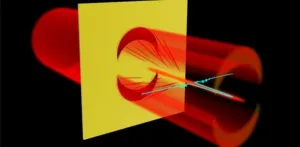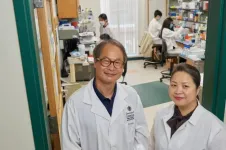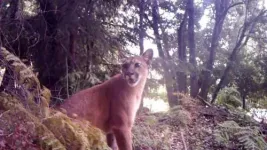(Press-News.org) ITHACA, N.Y. - Tossing worn-out solar panels into landfills may soon become electronics waste history.
Designing a recycling strategy for a new, forthcoming generation of photovoltaic solar cells - made from metal halide perovskites, a family of crystalline materials with structures like the natural mineral calcium titanate - will add a stronger dose of environmental friendliness to a green industry, according to Cornell University-led research published June 24 in Nature Sustainability.
The paper shows substantial benefits to recycling perovskite solar panels, though they are still in the commercial development stage, said Fengqi You, the Roxanne E. and Michael J. Zak Professor in Energy Systems Engineering in the College of Engineering.
"When perovskite solar panels reach the end of their useful life, how do we deal with this kind of electronic waste?" said You, also a faculty fellow at the Cornell Atkinson Center for Sustainability. "It is a new class of materials. By properly recycling it, we could potentially reduce its already low carbon footprint.
"As scientists design solar cells, they look at performance," You said. "They seek to know energy conversion efficiency and stability, and often neglect designing for recycling."
Last year, You and his laboratory found that photovoltaic wafers in solar panels containing all-perovskite structures outperform photovoltaic cells made from state-of-the-art crystalline silicon, and the perovskite-silicon tandem - with cells stacked like pancakes to better absorb light - perform exceptionally well.
Perovskite photovoltaic wafers offer a faster return on the initial energy investment than silicon-based solar panels because all-perovskite solar cells consume less energy in the manufacturing process.
Recycling them enhances their sustainability, as the recycled perovskite solar cells could bring 72.6% lower primary energy consumption and a 71.2% reduction in carbon footprint, according to the paper, "Life Cycle Assessment of Recycling Strategies for Perovskite Photovoltaic Modules," co-authored by Xueyu Tian, a doctoral student at Cornell Systems Engineering, and Samuel D. Stranks of the University of Cambridge.
"Lowering the energy needed to produce the cells indicates a significant reduction of energy payback and greenhouse gas emissions," said Tian.
The best recycled perovskite cell architecture could see an energy payback time of about one month, with a carbon footprint as low as 13.4 grams of carbon dioxide equivalent output per kilowatt hour of electricity produced. Without recycling, the energy payback time and carbon footprint of new perovskite solar cells show a range of 70 days to 13 months, and 27.5 to 158.0 grams of carbon dioxide equivalent throughout their life cycles.
Today's market-leading silicon photovoltaic cells can expect an energy payback period of 1.3 to 2.4 years, with an initial carbon footprint between 22.1 and 38.1 grams of carbon dioxide equivalent emissions per kilowatt hour output.
"Recycling makes perovskites outcompete all other rivals," Tian said.
Informed state and federal policies, along with recycling infrastructure development strategies, can further mitigate the environmental impacts in making photovoltaic solar cells.
Said You: "The real value of an effective green perovskite solar panel industry may rely on a recycling program."
INFORMATION:
The National Science Foundation supported this research.
ITHACA, N.Y. - As mosquito-borne diseases pose risks for half the world's population, scientists have been releasing sterile or genetically modified male mosquitos in attempts to suppress populations or alter their traits to control human disease.
But these technologies have failed to spread very rapidly because they require successful mating of modified mosquitoes with mosquitoes in nature and not enough research exists to fully explain which male traits females seek when they choose a mate.
Now, a new Cornell study of Aedes aegypti mosquitoes investigates how a mating cue called "harmonic convergence" might affect immunity against parasites, bacteria and dengue virus in offspring, which has important ...
HOUSTON - (June 24, 2021) - Hold on there, graphene. Seriously, your grip could help make better catalysts.
Rice University engineers have assembled what they say may transform chemical catalysis by greatly increasing the number of transition-metal single atoms that can be placed into a carbon carrier.
The technique uses graphene quantum dots (GQD), 3-5-nanometer particles of the super-strong 2D carbon material, as anchoring supports. These facilitate high-density transition-metal single atoms with enough space between the atoms to avoid clumping.
An international team led by chemical and biomolecular engineer Haotian Wang of Rice's Brown School of ...
Optical superoscillation refers to a wave packet that can oscillate locally in a frequency exceeding its highest Fourier component. This intriguing phenomenon enables production of extremely localized waves that can break the optical diffraction barrier. Indeed, superoscillation has proven to be an effective technique for overcoming the diffraction barrier in optical superresolution imaging. The trouble is that strong side lobes accompany the main lobes of superoscillatory waves, which limits the field of view and hinders application.
There also are tradeoffs between the main lobes and the side lobes of superoscillatory wave packets: reducing the superoscillatory feature size of the ...
Early in the COVID-19 pandemic, scientists identified how SARS-CoV-2, the virus that causes COVID-19, gets inside cells to cause infection. All current COVID-19 vaccines and antibody-based therapeutics were designed to disrupt this route into cells, which requires a receptor called ACE2.
Now, researchers at Washington University School of Medicine in St. Louis have found that a single mutation gives SARS-CoV-2 the ability to enter cells through another route - one that does not require ACE2. The ability to use an alternative entry pathway opens up the possibility of evading COVID-19 antibodies or vaccines, but the researchers did not find evidence of such evasion. However, the discovery does show that the ...
DUARTE, Calif. -- City of Hope, a world-renowned cancer research and treatment center, has identified how cancer cells in patients with early-stage breast cancer change and become resistant to hormone or combination therapies, according to a END ...
Scientists from Helmholtz Zentrum München revise the current textbook knowledge about gastrulation, the formation of the basic body plan during embryonic development. Their study in mice has implications for cell replacement strategies and cancer research.
Gastrulation is the formation of the three principal germ layers - endoderm, mesoderm and ectoderm. Understanding the formation of the basic body plan is not only important to reveal how the fertilized egg gives rise to an adult organism, but also how congenital diseases arise. In addition, gastrulation serves as the basis to understand processes during embryonic development called epithelial-to-mesenchymal transition which is known to lead to cancer metastasis in adulthood ...
When most Americans think of seaweed, they probably conjure images of a slimy plant they encounter at the beach. But seaweed can be a nutritious food too. A pair of UConn researchers recently discovered Connecticut-grown sugar kelp may help prevent weight gain and the onset of conditions associated with obesity.
In a paper published in the Journal of Nutritional Biochemistry by College of Agriculture, Health, and Natural Resources faculty Young-Ki Park, assistant research professor in the Department of Nutritional Sciences, and Ji-Young Lee, professor and head of the Department of Nutritional Sciences, the researchers reported significant findings supporting the nutritional benefits of Connecticut-grown sugar kelp. They found brown sugar kelp (Saccharina latissima) ...
FRANKFURT. Cancer and many other diseases are based on genetic defects. The body can often compensate for the defect of one gene; it is only the combination of several genetic errors that leads to the clinical picture. The 3Cs multiplex technique based on CRISPR-Cas technology developed at Goethe University Frankfurt now offers a way to simulate millions of such combinations of genetic defects and study their effects in cell culture. These "gene scissors" make it possible to introduce, remove and switch off genes in a targeted manner. For this purpose, small snippets of genetic material ("single ...
New research from the University of California, Santa Cruz shows how regional shelter-in-place orders during the coronavirus pandemic emboldened local pumas to use habitats they would normally avoid out of fear of humans. This study, published in the journal END ...
Roads, bridges, pipelines and other types of infrastructure in Alaska and elsewhere in the Arctic will deteriorate faster than expected due to a failure by planners to account for the structures' impact on adjacent permafrost, according to research by a University of Alaska Fairbanks Geophysical Institute permafrost expert and others.
The researchers say planners must account for the sideward repercussions of their projects in addition to the usual projection of the direct top-down effects.
The finding was presented in a May 31 paper in The Cryosphere, a publication of the European Geosciences Union.
UAF Geophysical Institute geophysics professor Vladimir Romanovsky is among the 13 authors ...





